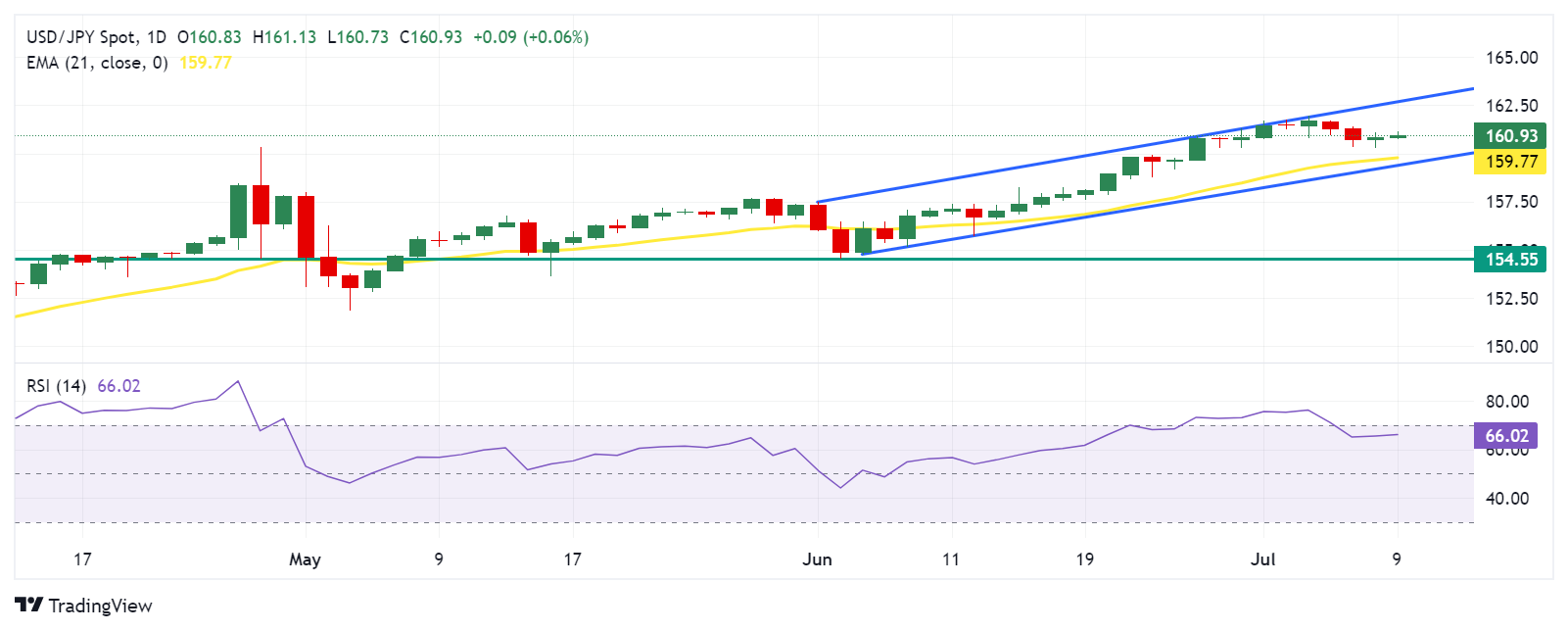- The Japanese Yen struggles due to overseas asset purchases by Japanese individuals through the NISA program.
- The BoJ is set to evaluate a viable strategy for reducing its government bond purchases.
- Fed Chair Powell may deliver a comprehensive review of the economy and monetary policy to the US Congress on Tuesday.
The Japanese Yen (JPY) depreciates for the second successive session on Tuesday. The minor improvement in the US Dollar (USD) underpins the USD/JPY pair. However, the JPY could limit its downside due to fears of intervention by Japanese authorities in the FX markets.
The Japanese Yen also struggles due to overseas asset purchases by Japanese individuals through the newly revamped tax-free investment scheme, the Nippon Individual Savings Account (NISA) program. According to Nikkei Asia, the scale of these purchases is expected to exceed the country's trade deficit during the first half of this year.
US Treasury yields are under pressure amid rising speculation that the Federal Reserve (Fed) may reduce interest rates in September, potentially limiting the upside of the US Dollar. The CME's FedWatch Tool indicates that rate markets price in a 76.2% probability of a rate cut in September, up from 65.5% just a week earlier.
Federal Reserve Chairman Jerome Powell will deliver his testimony on "The Semiannual Monetary Policy Report" to the US Congress on Tuesday. Powell may provide a broad overview of the economy and monetary policy, with his prepared remarks being published ahead of his appearance on Capitol Hill.
Daily Digest Market Movers: Japanese Yen declines due to foreign outflows
- On Tuesday, Japan's Finance Minister Shunichi Suzuki emphasized the importance of maintaining fiscal discipline to uphold confidence in long-term fiscal health. Suzuki also noted that he is closely monitoring discussions at the Bank of Japan (BoJ) meeting with the bond market, according to Reuters.
- According to a Bloomberg report on Tuesday, the Bank of Japan is conducting three in-person meetings with banks, securities firms, and financial institutions over the next few days. The purpose of these meetings is to assess a feasible pace for scaling back its purchases of Japanese Government Bonds.
- Japan’s Ministry of Finance reported on Monday that Japanese investment trust management companies and asset management firms bought ¥6.16 trillion ($38 billion) more in offshore equities and investment fund shares than they sold during the first six months of the year.
- Rabobank FX analysts note that they expect USD/JPY to hold around the 160 level over the next month, with the pair easing back to 152 by year-end. "The US Dollar (USD) could remain under pressure in the coming weeks, allowing USD/JPY to stay close to 160."
- On Monday, the Bank of Japan (BOJ) maintained its economic assessment for five of Japan's nine regions in its latest 'Sakura Report'. The assessment for two regions was raised, while it was lowered for another two regions in the report released on Monday. Regarding price trends, the BOJ noted that many regions report wage hikes spreading among smaller firms.
- Japan's Current Account surplus extended its growth streak to the 15th month in May. The Ministry of Finance reported on Monday that the current account increased to ¥2,849.9 billion ($17.78 billion) in May, up from ¥2,050.5 billion in the previous month, surpassing market expectations of ¥2,450.0 billion.
- US Nonfarm Payrolls (NFP) increased by 206,000 in June, following a rise of 218,000 in May. This figure surpassed the market expectation of 190,000.
- The Minutes from the Federal Reserve's June 11-12 monetary policy meeting, released on Wednesday, suggested that Fed officials were in a wait-and-see mode. "Some participants emphasized the Committee’s data-dependent approach, with monetary policy decisions being conditional on the evolution of the economy rather than being on a preset path."
Technical Analysis: USD/JPY rises to near 161.00
USD/JPY trades around 161.00 on Tuesday. The pair remains within an ascending channel pattern, indicating a bullish inclination based on daily chart analysis. Additionally, the momentum indicator, the 14-day Relative Strength Index (RSI), remains above the 50 level, confirming the bullish trend.
The USD/JPY pair could test the key resistance at the upper boundary of the ascending channel near the level of 162.55. A breakout above this level might strengthen bullish sentiment, potentially driving the pair toward psychological resistance at 163.00.
On the downside, the USD/JPY pair may find immediate support around the 21-day Exponential Moving Average (EMA) at 159.78. A break below this level could exert pressure on the pair to test the lower boundary of the ascending channel around 159.40. A further decline below this channel support could lead the pair to navigate the vicinity around June's low at 154.55.
USD/JPY: Daily Chart
Japanese Yen PRICE Today
The table below shows the percentage change of Japanese Yen (JPY) against listed major currencies today. Japanese Yen was the weakest against the Australian Dollar.
| USD | EUR | GBP | JPY | CAD | AUD | NZD | CHF | |
|---|---|---|---|---|---|---|---|---|
| USD | 0.02% | 0.02% | 0.02% | -0.01% | -0.11% | 0.04% | 0.04% | |
| EUR | -0.02% | -0.02% | 0.00% | -0.04% | -0.12% | 0.03% | 0.02% | |
| GBP | -0.02% | 0.02% | 0.02% | -0.03% | -0.09% | 0.04% | 0.04% | |
| JPY | -0.02% | 0.00% | -0.02% | -0.03% | -0.12% | 0.02% | 0.03% | |
| CAD | 0.00% | 0.04% | 0.03% | 0.03% | -0.11% | 0.07% | 0.05% | |
| AUD | 0.11% | 0.12% | 0.09% | 0.12% | 0.11% | 0.13% | 0.12% | |
| NZD | -0.04% | -0.03% | -0.04% | -0.02% | -0.07% | -0.13% | 0.00% | |
| CHF | -0.04% | -0.02% | -0.04% | -0.03% | -0.05% | -0.12% | -0.01% |
The heat map shows percentage changes of major currencies against each other. The base currency is picked from the left column, while the quote currency is picked from the top row. For example, if you pick the Japanese Yen from the left column and move along the horizontal line to the US Dollar, the percentage change displayed in the box will represent JPY (base)/USD (quote).
Japanese Yen FAQs
The Japanese Yen (JPY) is one of the world’s most traded currencies. Its value is broadly determined by the performance of the Japanese economy, but more specifically by the Bank of Japan’s policy, the differential between Japanese and US bond yields, or risk sentiment among traders, among other factors.
One of the Bank of Japan’s mandates is currency control, so its moves are key for the Yen. The BoJ has directly intervened in currency markets sometimes, generally to lower the value of the Yen, although it refrains from doing it often due to political concerns of its main trading partners. The current BoJ ultra-loose monetary policy, based on massive stimulus to the economy, has caused the Yen to depreciate against its main currency peers. This process has exacerbated more recently due to an increasing policy divergence between the Bank of Japan and other main central banks, which have opted to increase interest rates sharply to fight decades-high levels of inflation.
The BoJ’s stance of sticking to ultra-loose monetary policy has led to a widening policy divergence with other central banks, particularly with the US Federal Reserve. This supports a widening of the differential between the 10-year US and Japanese bonds, which favors the US Dollar against the Japanese Yen.
The Japanese Yen is often seen as a safe-haven investment. This means that in times of market stress, investors are more likely to put their money in the Japanese currency due to its supposed reliability and stability. Turbulent times are likely to strengthen the Yen’s value against other currencies seen as more risky to invest in.
Information on these pages contains forward-looking statements that involve risks and uncertainties. Markets and instruments profiled on this page are for informational purposes only and should not in any way come across as a recommendation to buy or sell in these assets. You should do your own thorough research before making any investment decisions. FXStreet does not in any way guarantee that this information is free from mistakes, errors, or material misstatements. It also does not guarantee that this information is of a timely nature. Investing in Open Markets involves a great deal of risk, including the loss of all or a portion of your investment, as well as emotional distress. All risks, losses and costs associated with investing, including total loss of principal, are your responsibility. The views and opinions expressed in this article are those of the authors and do not necessarily reflect the official policy or position of FXStreet nor its advertisers. The author will not be held responsible for information that is found at the end of links posted on this page.
If not otherwise explicitly mentioned in the body of the article, at the time of writing, the author has no position in any stock mentioned in this article and no business relationship with any company mentioned. The author has not received compensation for writing this article, other than from FXStreet.
FXStreet and the author do not provide personalized recommendations. The author makes no representations as to the accuracy, completeness, or suitability of this information. FXStreet and the author will not be liable for any errors, omissions or any losses, injuries or damages arising from this information and its display or use. Errors and omissions excepted.
The author and FXStreet are not registered investment advisors and nothing in this article is intended to be investment advice.
Recommended content
Editors’ Picks

AUD/USD clings to recovery gains above 0.6200, focus shifts to US ISM PMI
AUD/USD sustains the recovery from two-year troughs, holding above 0.6200 in Friday's Asian trading. The pair finds footing amid a pause in the US Dollar advance but the upside appears elusive as markets turn cautious amid China concerns and ahead of US ISM PMI data.

USD/JPY eases toward 157.00 as risk sentiment sours
USD/JPY is extending pullback from multi-month high of 158.07 set on Thursday. The pair drops toward 157.00 in the Asian session on Friday, courtesy of the negative shift in risk sentiment. Markets remain concerned about China's econmic health and the upcoming policies by the Fed and the BoJ.

Gold flat lines above $2,650 ahead of US PMI release
Gold price consolidates its gains near $2,660 after reaching a two-week high during the early Asian session on Friday. The safe-haven flows amid the geopolitical tensions provide some support to the precious metal.

Could XRP surge to new highs in January 2025? First two days of trading suggest an upside bias
Ripple's XRP is up 7% on Thursday, extending its rally that began during the New Year's Day celebration. If long-term holders continue their recent accumulation, XRP could overcome the $2.9 resistance level and aim for a new all-time high.

Three Fundamentals: Year-end flows, Jobless Claims and ISM Manufacturing PMI stand out Premium
Money managers may adjust their portfolios ahead of the year-end. Weekly US Jobless Claims serve as the first meaningful release in 2025. The ISM Manufacturing PMI provides an initial indication ahead of Nonfarm Payrolls.

Best Forex Brokers with Low Spreads
VERIFIED Low spreads are crucial for reducing trading costs. Explore top Forex brokers offering competitive spreads and high leverage. Compare options for EUR/USD, GBP/USD, USD/JPY, and Gold.
